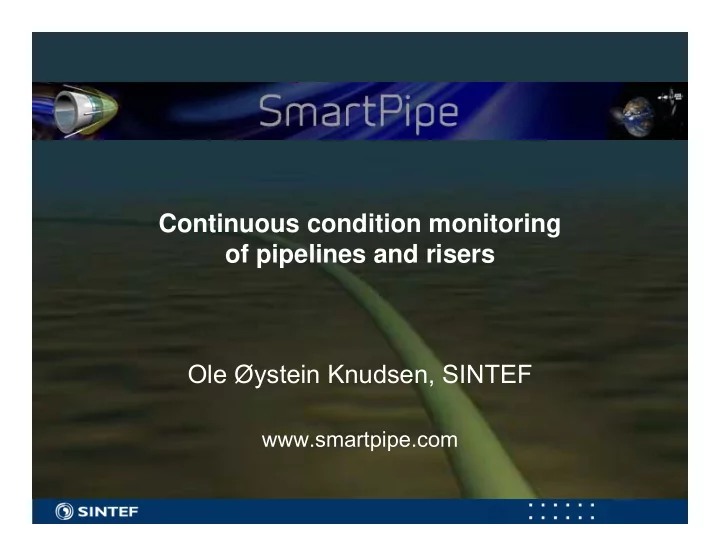

Continuous condition monitoring of pipelines and risers Ole Øystein Knudsen, SINTEF www.smartpipe.com ICT 1
The SmartPipe vision An on-line system reporting the technical condition of the pipeline through a combination of sensors, degradation models, and analysis tools Self-contained, distributed sensors packages with locally produced power and wireless communication ICT 2
General system requirements No interference with laying operations Non intrusive sensors Low cost, simple, robust Lifetime >20 years Interfacing to existing sensor technology Low power consumption Local processing to reduce needed communication capacity ICT 3
Key parts Data collection Data interpretation Decision making • Sensors • Communication • Power • Materials degradation • Analysis tools • Database • Technical condition • Warnings • Simulations • Visualisation ICT 4
Lithium batteries ICT 5
SmartPipe Communication Sensors Wireless electromagnetic signal Ultrasound wall thickness in coating measurement Strain gauges for measuring deflection and internal pressure Power Thermistor for temperature A package of conventional Lithium batteries Accelerometer for measuring vibrations and inclination Thermoelectric generator ICT 6
Battery packing Four cells in series inserted in steel tubes 300 mm length Space available for charge balancing electronics Hermetically sealed to prevent water intrusion Five 14.4 V battery packs encased in exterior bracelet 40 cells in total (120% capacity) Close contact to cold sea water beneficial for battery lifetime Exterior bracelet can be partially embedded in PP- insulation. ICT 7
Thermoelectric generator For pipes exposed to seawater the thermoelectric generator is capable to generate enough power. The communication system will be operational only when there is a hot flow in the pipe No data during installation phase No data in shut-down period The preliminary conservative estimates For trenched pipes an energy for a single Peltier element module storage must be used to get Buried Not buried enough power when the 20 % of Δ T 50 % of Δ T tot Δ T over Peltier over Peltier electronics is active (super capacitor) 50 °C 6 mW 35 mW 70 °C 12 mW 70 mW ICT 8
Antenna Communication Electromagnetic wave in the coating Inter node distance: 24 m Redundancy distance: 72 m (three nodes) Carrier frequency: 5 MHz Propagation loss: 0.5 dB/meter Patent application submitted ICT 9
Local analysis: • Fracture • Fatigue (fracture mech.) • Local buckling • Plastic collapse • Burst Global analysis: • Installation simulation • Free-span analysis • Fatigue (stress range/SN based) • Global buckling • Upheavals/snaking • On-bottom stability Corrosion analysis: • Corrosion rates • Wall thickness reduction • Safe operation windows ICT 10
SmartPipe data management Degrada- tion analysis Host Fibre machine modem or Data base Data powerline collecion modem system Visuali- sation tools Cable or optical fibre Sub- sea Cable or optical fibre Fibre Fibre Pick-up modem or modem or antenna on powerline powerline outside of modem modem pipe ICT 11
Mounting concept Mounting in field-joint is the most feasible solution Belt with hardware fixed to FBE coating with adhesive and strap. Molded into the PP coating Standard coating procedure ICT 12
Demonstrator 24 meter long 10” pipe with 70 mm PP insulation 4 sensor belts with communication units distributed along the pipe. In addition one anode pad Belts mounted in field-joints on top of FBE coating Produced in February 2009 Tested in May 2009 Technip spool base ICT 13
Demonstrator Summer 2009 Communication Sensor data 0.8 m A B C Anode 24 m ICT 14
”Reeling” test at Bredero Shaw 090625 4 cycles bending to radius of 8,225 m and straightening No cracks or fractures in PP coating No problems in any of the installed sensors occurred during the test ICT 15
”Reeling” test – strain gauges Measured strain during bend-test 1500 1000 500 S1 Microstrain S2 S3 0 S4 0 100 200 300 400 500 600 700 800 S5 S6 -500 -1000 -1500 Time [Seconds] Belt C: no sign of reduced contact with steel surface after 3 ”reeling” cycles ICT 16
Reeling test - Ultrasound US-6 before bending 3,00E+11 2,50E+11 4 ultrasound 2,00E+11 transducers tested 1,50E+11 Signal US-6 1,00E+11 No signs of reduced 5,00E+10 contact with steel 0,00E+00 -5,00 0,00 5,00 10,00 15,00 20,00 25,00 30,00 35,00 40,00 -5,00E+10 surface Time (microseconds) US-6 after bending No signs of reduced 3,00E+11 energy in reflected 2,50E+11 2,00E+11 signal 1,50E+11 Signal US-6 1,00E+11 5,00E+10 0,00E+00 -5,00 0,00 5,00 10,00 15,00 20,00 25,00 30,00 35,00 40,00 -5,00E+10 Time (microseconds) ICT 17
Temperature test at SINTEF 090914 Heated oil circulated in closed test pipe Test temperature 20-140 o C No functional problems discovered with sensor system or interfaces Strain gauges will relax when Tg of glue is passed ICT 18
SUMMARY Sensors and electronics survives field joint moulding and reeling Less than 2 minutes required to install the sensor hardware on the pipe. Antennas are successfully installed. The electromagnetic waves were successfully transmitted in the coating, and signal loss was as previously modeled. Transition to an industrialized production and mounting procedure seems feasible. • Alternative glue must be used for operating temperatures over Tg of PP adhesive ICT 19
Where are we today? Phase 2 Phase 1 General development Design and of the system and testing of pilot verification 2006-2009 2010-2012 Application for Phase 2 to be submitted autumn 2009 More companies are welcome to join in Phase 2 ICT 20
The consortium ICT 21
Recommend
More recommend